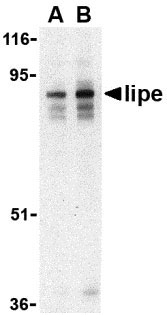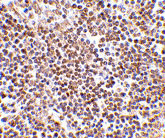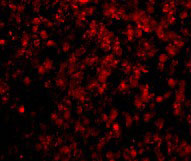Lipe Antibody
- 产品详情
- 实验流程
- 背景知识
Application
| WB, IF, E, IHC-P |
|---|---|
| Primary Accession | Q05469 |
| Other Accession | ABA03168, 896474 |
| Reactivity | Human, Mouse, Rat |
| Host | Rabbit |
| Clonality | Polyclonal |
| Isotype | IgG |
| Calculated MW | 116598 Da |
| Concentration (mg/ml) | 1 mg/mL |
| Conjugate | Unconjugated |
| Application Notes | Lipe antibody can be used for detection of Lipe by Western blot at 0.5 - 1 µg/mL. Antibody can also be used for immunohistochemistry starting at 2.5 µg/mL. For immunofluorescence start at 20 µg/mL. |
| Gene ID | 3991 |
|---|---|
| Other Names | Lipe Antibody: HSL, LHS, Hormone-sensitive lipase, HSL, lipase, hormone-sensitive |
| Target/Specificity | LIPE; Multiple isoforms of Lipe are known to exist. |
| Reconstitution & Storage | Lipe antibody can be stored at 4℃ for three months and -20℃, stable for up to one year. As with all antibodies care should be taken to avoid repeated freeze thaw cycles. Antibodies should not be exposed to prolonged high temperatures. |
| Precautions | Lipe Antibody is for research use only and not for use in diagnostic or therapeutic procedures. |
| Name | LIPE |
|---|---|
| Function | Lipase with broad substrate specificity, catalyzing the hydrolysis of triacylglycerols (TAGs), diacylglycerols (DAGs), monoacylglycerols (MAGs), cholesteryl esters and retinyl esters (PubMed:15716583, PubMed:15955102, PubMed:19800417, PubMed:8812477). Shows a preferential hydrolysis of DAGs over TAGs and MAGs and preferentially hydrolyzes the fatty acid (FA) esters at the sn-3 position of the glycerol backbone in DAGs (PubMed:19800417). Preferentially hydrolyzes FA esters at the sn-1 and sn-2 positions of the glycerol backbone in TAGs (By similarity). Catalyzes the hydrolysis of 2-arachidonoylglycerol, an endocannabinoid and of 2-acetyl monoalkylglycerol ether, the penultimate precursor of the pathway for de novo synthesis of platelet-activating factor (By similarity). In adipose tissue and heart, it primarily hydrolyzes stored triglycerides to free fatty acids, while in steroidogenic tissues, it principally converts cholesteryl esters to free cholesterol for steroid hormone production (By similarity). |
| Cellular Location | Cell membrane. Membrane, caveola. Cytoplasm, cytosol. Lipid droplet {ECO:0000250|UniProtKB:P54310}. Note=Found in the high-density caveolae. Translocates to the cytoplasm from the caveolae upon insulin stimulation (PubMed:17026959). Phosphorylation by AMPK reduces its translocation towards the lipid droplets (By similarity) {ECO:0000250|UniProtKB:P54310, ECO:0000269|PubMed:17026959} |
| Tissue Location | Testis.. |
For Research Use Only. Not For Use In Diagnostic Procedures.
Provided below are standard protocols that you may find useful for product applications.
BACKGROUND
Lipe Antibody: Although initially described as an adipocyte-specific triacylglycerol lipase, Lipe (also known as hormone-specific lipase or HSL) is expressed in multiple tissues and cell lines. It plays multiple roles in lipid metabolism, including hormone-stimulated lipolysis in adipose tissue and the hydrolysis of cholesterol esters. Lipe is expressed as a long and a short form, generated by use of alternative translational start codons. The long form is expressed in steroidogenic tissues such as testis, where it converts cholesterol esters to free cholesterol for steroid hormone production. The short form is expressed in adipose tissue, among others, where it hydrolyzes stored triglycerides to free fatty acids. Recently, it was observed that the lack of Lipe in genetically obese leptin-null mice inhibited obesity and adipogenesis, suggesting that Lipe plays a major role in adipocyte proliferation.
REFERENCES
Yeaman SJ. Hormone-sensitive lipase - new roles for an old enzyme. Biochem. J. 2004; 379:11-22.
Holst LS, Langin D, Mulder H, et al. Molecular cloning, genomic organization, and expression of a testicular isoform of hormone-sensitive lipase. Genomics 1996; 35:441-7.
Kraemer FB, Shen WJ, Harada K, et al. Hormone-sensitive lipase is required for high-density lipoprotein cholesterol ester-supported adrenal steroidogenesis. Mol. Endocrinol. 2004; 18:549-57.
Sekiya M, Osuga J, Okazaki H, et al. Absence of hormone-sensitive lipase inhibits obesity and adipogenesis in Lep ob/ob mice. J. Biol. Chem.2004; 279:15084-90.
终于等到您。ABCEPTA(百远生物)抗体产品。
点击下方“我要评价 ”按钮提交您的反馈信息,您的反馈和评价是我们最宝贵的财富之一,
我们将在1-3个工作日内处理您的反馈信息。
如有疑问,联系:0512-88856768 tech-china@abcepta.com.























 癌症的基本特征包括细胞增殖、血管生成、迁移、凋亡逃避机制和细胞永生等。找到癌症发生过程中这些通路的关键标记物和对应的抗体用于检测至关重要。
癌症的基本特征包括细胞增殖、血管生成、迁移、凋亡逃避机制和细胞永生等。找到癌症发生过程中这些通路的关键标记物和对应的抗体用于检测至关重要。 为您推荐一个泛素化位点预测神器——泛素化分析工具,可以为您的蛋白的泛素化位点作出预测和评分。
为您推荐一个泛素化位点预测神器——泛素化分析工具,可以为您的蛋白的泛素化位点作出预测和评分。 细胞自噬受体图形绘图工具为你的蛋白的细胞受体结合位点作出预测和评分,识别结合到自噬通路中的蛋白是非常重要的,便于让我们理解自噬在正常生理、病理过程中的作用,如发育、细胞分化、神经退化性疾病、压力条件下、感染和癌症。
细胞自噬受体图形绘图工具为你的蛋白的细胞受体结合位点作出预测和评分,识别结合到自噬通路中的蛋白是非常重要的,便于让我们理解自噬在正常生理、病理过程中的作用,如发育、细胞分化、神经退化性疾病、压力条件下、感染和癌症。








